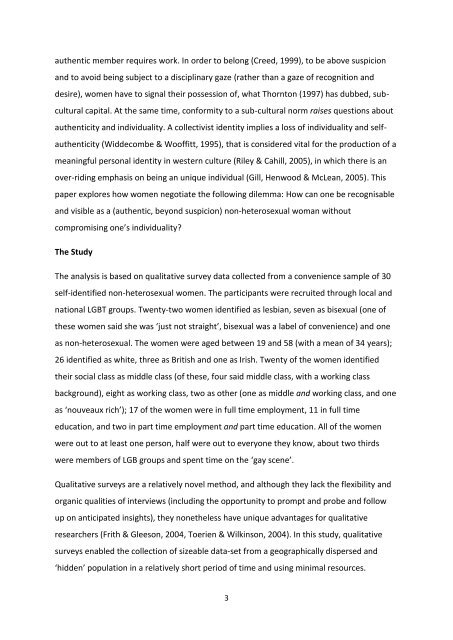Clarke, V. and Spence, K. (2012) I am who I am? Navigating norms ...
Clarke, V. and Spence, K. (2012) I am who I am? Navigating norms ...
Clarke, V. and Spence, K. (2012) I am who I am? Navigating norms ...
Create successful ePaper yourself
Turn your PDF publications into a flip-book with our unique Google optimized e-Paper software.
authentic member requires work. In order to belong (Creed, 1999), to be above suspicion<br />
<strong>and</strong> to avoid being subject to a disciplinary gaze (rather than a gaze of recognition <strong>and</strong><br />
desire), women have to signal their possession of, what Thornton (1997) has dubbed, sub-<br />
cultural capital. At the s<strong>am</strong>e time, conformity to a sub-cultural norm raises questions about<br />
authenticity <strong>and</strong> individuality. A collectivist identity implies a loss of individuality <strong>and</strong> self-<br />
authenticity (Widdecombe & Wooffitt, 1995), that is considered vital for the production of a<br />
meaningful personal identity in western culture (Riley & Cahill, 2005), in which there is an<br />
over-riding emphasis on being an unique individual (Gill, Henwood & McLean, 2005). This<br />
paper explores how women negotiate the following dilemma: How can one be recognisable<br />
<strong>and</strong> visible as a (authentic, beyond suspicion) non-heterosexual woman without<br />
compromising one’s individuality?<br />
The Study<br />
The analysis is based on qualitative survey data collected from a convenience s<strong>am</strong>ple of 30<br />
self-identified non-heterosexual women. The participants were recruited through local <strong>and</strong><br />
national LGBT groups. Twenty-two women identified as lesbian, seven as bisexual (one of<br />
these women said she was ‘just not straight’, bisexual was a label of convenience) <strong>and</strong> one<br />
as non-heterosexual. The women were aged between 19 <strong>and</strong> 58 (with a mean of 34 years);<br />
26 identified as white, three as British <strong>and</strong> one as Irish. Twenty of the women identified<br />
their social class as middle class (of these, four said middle class, with a working class<br />
background), eight as working class, two as other (one as middle <strong>and</strong> working class, <strong>and</strong> one<br />
as ‘nouveaux rich’); 17 of the women were in full time employment, 11 in full time<br />
education, <strong>and</strong> two in part time employment <strong>and</strong> part time education. All of the women<br />
were out to at least one person, half were out to everyone they know, about two thirds<br />
were members of LGB groups <strong>and</strong> spent time on the ‘gay scene’.<br />
Qualitative surveys are a relatively novel method, <strong>and</strong> although they lack the flexibility <strong>and</strong><br />
organic qualities of interviews (including the opportunity to prompt <strong>and</strong> probe <strong>and</strong> follow<br />
up on anticipated insights), they nonetheless have unique advantages for qualitative<br />
researchers (Frith & Gleeson, 2004, Toerien & Wilkinson, 2004). In this study, qualitative<br />
surveys enabled the collection of sizeable data-set from a geographically dispersed <strong>and</strong><br />
‘hidden’ population in a relatively short period of time <strong>and</strong> using minimal resources.<br />
3

















